1) THIS YEAR ACT UP is 25 years old, AIDS just over 30, and an excellent documentary How To Survive A Plague about the former (and, of course, the latter) was released a couple weeks ago. “Most inspiring film this year” has been said about it frequently. It’s true. Also true is what it shows that people can do if your heart is set to it. Or, if you face a death sentence. And, you are middle class and male and white and have (because of those three things) been brought up to believe you can change the world. There is a certain entitlement to those three things, but that isn’t to say that ACT UP continued to be defined by them. In fact, part of what the group did was invite in many voices to speak and fight: women, Hispanics, blacks.
2) The movie’s release is the occasion for this piece, but it is not the piece, though parts of it (pieces of the piece, if you will) will address the movie. For reviews there is Andrew O’Hehir’s excellent piece in Salon and this one in the SF Chronicle. There are countless others too. The movie I will say again is inspiring. See it.
3 ) The AIDS Quilt is in the movie. In it Liz Taylor intones the names of people she knew who died. Including Rock Hudson.
4) He made AIDS visible. So, did Magic Johnson. He got AIDS from having “multiple sexual partners.” He has never said exactly what this means.
5) Visibility: Karposi’s Sarcomi. A complication of AIDS, it’s a cancer that blotted the skin with red and purple marks before it attacked the lungs and killed. KS made the virus visible. It was a literal scarlet mark, a scarlet letter.
6) The AIDS Quilt: For years I thought the quilt was kind of cheesy. Cheesy isn’t quite the word, but the quilt seemed like this folksy thing that prettified the disease, that didn’t get at the horrors of the deaths or inactions of governments. With time though I find it achingly moving, and what was cheesy before, the folk art part of it, now is what I value. It’s poignant seeing how people have memorialized their friends and lovers. The quilt itself falls into a very American craft tradition, which seems important now. Not because it “recuperates” these people to that tradition, but because the quilt says that these deaths are our deaths. They are part of who we all are.
7) AIDS Quilt II. The last time it was shown in full was in 1996 on the Mall in Washington DC. This summer it was shown again in its entirety. Also, this year a map of the entire quilt was put online. Go look at it. It’s staggering.
8) In 1988 Gran Fury, ACT UP’s art and propaganda wing ran an ad in the Village Voice saying, “Art is not enough.” The idea being that to use art, something pretty or aesthetic to talk about AIDS wasn’t good enough. It wasn’t enough to make a quilt, and at the time art was often being used to raise “awareness.” One group of conceptual artists took Gary Indiana’s “Love” sculpture (you know the one with the “O” on its side?) and remade it with “AIDS.” (The “D” was flipped). As if AIDS led to LOVE (or vice versa). Instead one Gran Fury member painted a version that said “RIOT.” “Because,” another member Marlene McCarty recalled recently, “AIDS makes us want to riot.”
9) How do you respond if someone tells you two-thirds of you will die? This is what Larry Kramer tells a group of (mostly) men in 1987 at the Gay and Lesbian Community Center in the West Village. Anger is appropriate. So is rioting. So too is kissing as a protest. This is ACT UP’s founding moment.
10) You kiss as a protest in a hospital because the doctors, nurses and administrators are scared of AIDS patients (though the hospital is in the West Village). Because they abuse their gay and lesbian patients. This is a time when, being gay and lesbian, you have no rights. Your partner cannot visit you as you die because he or she is not a spouse and not family. And, if your partner dies, you will not inherit the house or apartment or money. Chances are you will lose your rented apartment. Your landlord can kick you out.
11) Five years later I am in the same hospital in a waiting room in a clinic that has been set up to deal specifically with AIDS. I am there with a friend. I don’t remember the reason for the visit. Was there a problem? Was it a checkup? It must be a problem since I am with him. What I remember though: the dirty tiles floors and the molded plastic chairs bolted to the floor, a fan on, the heat, a woman in flip flops and her cracked heels. And, I can’t remember why my friend is there.
12) This friend and I lie on a bed in his apartment on St Marks Place and talk about his T cell count. At this point AZT is not working. It’s the only available treatment, and it’s not working for my friend. His T cells are low; the numbers down in the double digits, which translates into a severely compromised immune system. I remember the bed and the apartment (a floor-through). I remember his beard and his taste in men – he’s a bear —and the small squirrel of fear in his voice as he talks about numbers. The words get tight and small. He says he doesn’t know how long he’ll live.
13) In the movie over and over men say they don’t expect to outlive the disease. “Do you think you’ll live to see a cure?” a voice off camera says. “No, no.” A man studies his hands and looks at the camera, and the look is direct and also haunted. Imagine being 22, 24, 28, 32 … and knowing that you are facing your death soon because science and governments have failed you. Of course, art isn’t enough.
14) Ronald Reagan is well into his second term before he even utters the word AIDS.
15) I am writing about AIDS like this, in fragments and personally because I don’t know how else to. The idea that I can hold a through-line here is ridiculous. The personal feels not political as the feminist maxim goes, but here like a failure. Who am I, and what is my experience in the face of this? Vastly small. So tiny it’s superfluous, but this is what I have to give you. It is not enough. I know this but this is all I have now. I am not a reviewer here. I returned from whatever war that was (still is), from whatever front at which we fought, and have these few bones to show for it. I understand they are paltry.
16) AIDS now that it is “cured” is leading to heart problems in people with the disease. Today my neighbor who is my cousin (this isn’t some metaphoric your-neighbor-is-your-brother construction but literal) has had bypass operations and many stents. He has AIDS. Seeing him in the ICU with frail bare legs and flimsy hospital gown, clutching a stuffed heart made of gingham to his chest is shattering. It’s the new face of AIDS. The disease is leading to this scene being repeated across the country countless times. People think AIDS isn’t here. Or, that it’s better – that it’s curable. Here it is though. In this hospital room (not even a room because all that separates him from the nurse’s station is a thin curtain, while his husband clenches and unclenches his fists. This is AIDS on combination therapy. It is my neighbor / cousin – in the hospital after a bypass. AIDS is attacking people’s hearts because what else is there to go for but the heart? As if a disease like this could go for anything else?
17) The current statistic for people living worldwide with HIV is over 35 million.
18) This would be the appropriate place for a joke. I would like some humor here, please.
19) Funny: ACT UP had a subgroup called the Power Tools. In How to Survive a Plague, you can see them in suits in North Carolina outside the bracing modernist structure that is Burroughs Wellcome’s US HQ. Wellcome was the maker of AZT. At the time AZT cost $10,000. It was the most expensive drug ever. It was also the only drug anywhere near effective against AIDS. The men are baby faced and clean scrubbed and handcuffed and talking to camera. The men in suits went into the building in their businessmen’s drag, clutching briefcases and asked for the restroom. They proceeded to another room, where with drills and steel plates they locked themselves in as a protest and tried unfurl a banner saying denouncing Wellcome from the window. They pay for all damages, so as not to be portrayed as terrorists or vandals. The group the Power Tools was named for a Jeff Stryker movie. That is funny.
20) Peter Staley, a former closeted bond trader, came out and quit his job when he was diagnosed. He started the Power Tools; he is one of my heroes.
21) He says now, “The bondswoman in Durham thought she had us over a barrel when she levied the maximum bail against the four of us at $5,000 each, for a total of $20,000. I had prepared for this, and said, “Do you take traveler’s checks?” She was stunned as I whipped out a big stack of traveler’s checks totaling exactly $20,000, and spent the next ten minutes signing them all.” Imagine the look on her face. That is also funny.
22) Later that year in September, five men slip onto the trading floor of the New York Stock Exchange. Sweeping in with a swarm of smokers rushing for the start of trading, they chain themselves to a balcony. Seconds before the bell goes off, they drown it out with air horns and unfurl a banner. “Sell Wellcome!” Chaos ensues. Trading can’t start – the only time in history it’s interrupted. Dollars rain down on traders. Fake tens, 50s and 100s, emblazoned on the backs, “Fuck Your Profiteering. People are dying while you play business,” and, “White Heterosexual men can’t get AIDS… Don’t bank on it” drift to the floor. Traders are rabid when they realize these are AIDS protestors. Outside 1500 people gather, carrying signs of bloody hands and handing out the fake bills. The next day photos of the scene make the front pages of The Wall Street Journal and The New York Times, and two days later, Burroughs Wellcome lowers the price of the antiretroviral drug AZT by 20 per cent, from USD $10,000 a year (at that time the most expensive drug in history) to USD $8,000. This is also the Power Tools. (The dollars were made by Gran Fury).
23) “Terrorists.” ACT UP was labeled a terrorist organization. Congressman Dannemayer sent letters to the FBI on behalf of Jesse Helms because of a quote In Mother Jones magazine by an ACT UP member. In 1989 the FBI was following ACT UP members and had established policy about what to do should ACT UP carry out a “terrorist act on foreign soil against a US national.” They were worried about an “attack” at an international AIDS conference scheduled in Toronto. In our age of post 9/11, this seems almost quaint – and funny. Scary funny.
24) Gran Fury was also funny. They were named for a police cruiser and had a cursive logo that looks like a pretty flourish.
25) Gran Fury could also be like Buster Keaton. They were included in the prestigious Venice Biennale in 1990 and planned on doing a piece that highlighted the Catholic Church’s stance on condoms (they are a mortal sin). The Furies thought basically when in Rome (or, at least, close in Venice) take on the Church. Their installation at the Biennale was called “The Pope And The Penis.” It was going to combine a poster of the Pope with a poster the group had designed of an erect cock saying, “Men wear a condom or beat it.” Somehow rumors of the content got out, spread by the USIA that Gran Fury was going to put the Pope on a penis, perhaps on the balls. Rather than the Pope AND the Penis. Semantics. It’s a fine difference between “and” and “on.”
Gran Fury’s work was held in customs and wouldn’t be released. They were told they were committing heresy. (“Heresy?” one of them said recently. “Doesn’t that just make you think of the 1500s?”) Officials weren’t going to give the group their work for the press opening. GF staged a sit-in in the director’s office. All the other artists threatened to take down their work if GF didn’t get its back. Mad-cap antics ensued, including, once they got the art, running around Venice to elude authorities so they wouldn’t take it back. They even hid the pieces in dumpsters at a pizza parlor. Finally the work was hung, and the piece did have a penis and the Pope’s head and it did challenge papal authority. It also got invaluable news coverage.
[Funny footnote. This was the year of cocks at the Venice Biennale. On the other side of the wall from Gran Fury, Jeff Koons did an installation of sculptures of his having sex with Cicciolina, a porn star and member of the Italian parliament. This did not upset anyone. Politicians and penises? Okay. The Pope? No. Go figure.]
26) Funny is good in the face of AIDS. “Laugh till you cry.” “You killed me.” “You’re killing me with laughter.” “You slayed it.” There is a very fine line between laughing and death and sadness. Sometimes you are on both sides at the same time.
27) Truly funny: ACT UP went to Arlington, Va. to Senator Jesse Helms’ house and put a giant condom over it, because, as the condom itself said: “Helms is deadlier than a virus.”
a) In 1987 he called AIDS’ prevention literature, “So obscene, so revolting I may throw up.”
b) His “Helms amendment” added HIV to the exclusion list for people entering the US. The amendment was passed unanimously in the Senate.
c) He opposed AIDS research bills in the Senate saying, “There is not one single case of AIDS in this country that cannot be traced in origin to sodomy.”
[NB: he also filibustered against giving Martin Luther King Jr. a federal holiday]
d) In 2002, he apologized for not doing more for AIDS. In Africa. To you, who are gay and in the US, he wasn’t sorry.
28) The early 90s ≠ funny. People were dying; there was no cure, no combination therapy yet, no hope of even anything called a combination therapy or a protease inhibitor (which literally inhibits the virus’s replication). That time felt more hopeless than the early years when activists thought if you threw enough money, efforts, protests at the virus, you could change the disease, you could cure it.
29) By 1991 one out of seven New Yorkers were predicted to get AIDS, and the disease was the biggest killer of men and women in the city between 25 and 44.
30) I was 18 when ACT UP was formed, and came to New York City for college terrified of the disease. I had unprotected sex and plenty of it. Did you? Do you? What does risk feel like now? Women are particularly vulnerable to contracting HIV/AIDS from sex – and the disease is disproportionate. It impacts hispanic and African American women more than white ones. 79% of all new cases are minorities. “Minorities” are not the minority.
31) Six years later I was lying on my friend’s bed talking about his T cells.
32) The film’s most devastating moment is from that year. Protesters march on the White House. They throw ash into the Rose Garden. This is not just any ash, not fireplace ash, not from your BBQ grill. They march with urns and cardboard boxes and plastic bags with the cremated remains of lovers and children and friends. This is ash with bone fragments like sea shells in it.
One friend of mine describes holding onto another friend’s pant leg as he scales the fence to throw what is left of his boyfriend onto the grass. It’s haunting to watch scenes like this. Throwing ash like this is not what we do with the dead; the act is full of desperation and loss. Faces are ripped in pain. “I love you Mike. I love you,” one man yells as he dumps an urn’s contents. It’s impossible to imagine this happening now with the “War on Terror” and the barricades that prevent you getting anywhere near the White House. It is also nearly impossible to imagine because it’s so transgressive to throw remains away like that.
33) I cry both times I see it on film. I weep here for the fact that I remember the cracked feet and dirty waiting room at St. Vincent’s but not why I’m there. And, for the friend whose dementia scares me so much I don’t know how to accept his needs. Imagine someone with dementia in their mid 30s. Dying.
34) As he’s dying, the friend with dementia wants to kiss me. I am terrified of his blubbery affection. I know kissing doesn’t kill, but I am also terrified of the person I’m facing. The one I knew has disappeared and here is this man who wants intimacy I can’t give. He’s gay and I am straight, for whatever those words mean. I’m scared and we are sitting on his sofa in his little studio apartment. I turn away from him. I am still ashamed by that turning away. Is anyone ever prepared for this at 24?
35) He starts taking heroin again shortly before his death. How shortly? I can’t remember, but when I find out, I don’t know he will die within the year. I wonder if he knew he wasn’t going to get better, if he could feel himself dying if the heroin hastened his death, if dealing with the constant thing of maybe dying drove him back to drugs? If the side effects of AZT did? Was he on AZT? I don’t remember. All these are things I cannot tell you, they make me weep.
36) I can tell you he had two memorial services, one for the family, the other in a loft a couple weeks later for friends. The weekend of the second I go home for my oldest sister’s birthday. I fight with my boyfriend before I leave, and when I get back, go straight to the service. He won’t speak to me. We have broken up. I can tell you about the sister. I can tell you about how it felt to leave the service with two plastic jewel cases in my hand. Everyone was given two CDs from the friend’s collection. The plastic felt like bones. I can’t tell you more though. I can’t tell you where the loft was or what was said, but I remember feeling of sitting on the wood floor, numb, as if my body had been shot full of Novocain. The now ex-boyfriend, who was my boyfriend on Friday but is not on Sunday, is across the room. I can tell you about the room the size of a broom closet where afterwards I pleaded for us to stay together. He moved into the friend’s apartment whose service we were at.
37 ) When I see the ashes thrown and the pain onscreen, these are the things I cry for.
38) Ribbons and wristbands have made protest commonplace. They smooth over anger and grief, turning them into nothing more than something you can pin on your chest and feel okay about. Maybe a few cents from every purchase will go to fight for a cure. That is not the same as fighting.
39) ACT UP teaches us how to fight. How To Survive A Plague makes that lesson seems as relevant now as it was 25 years ago.

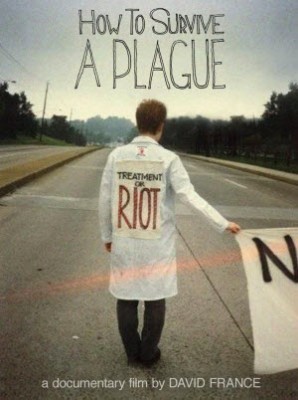
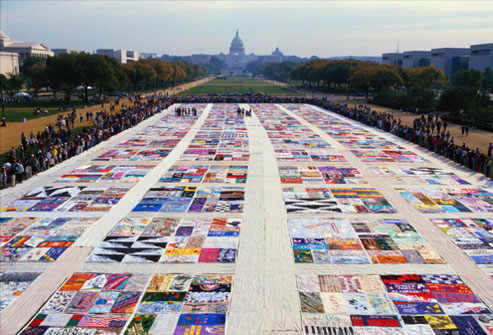
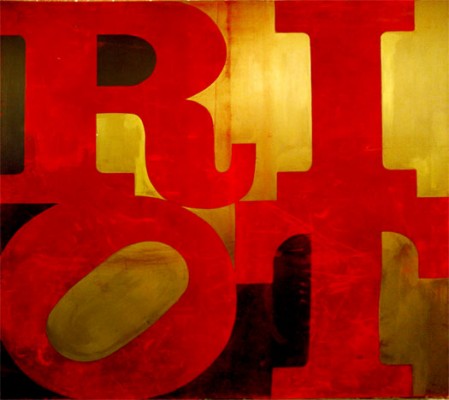
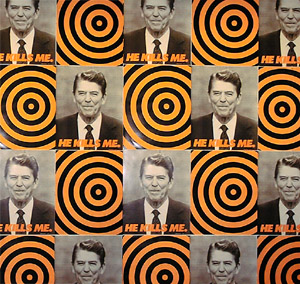
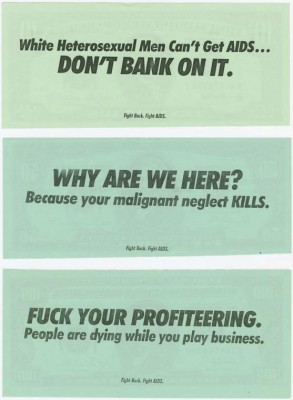
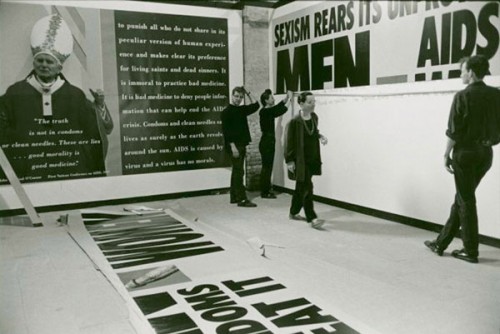
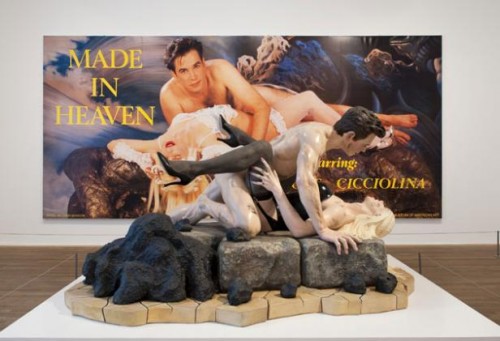
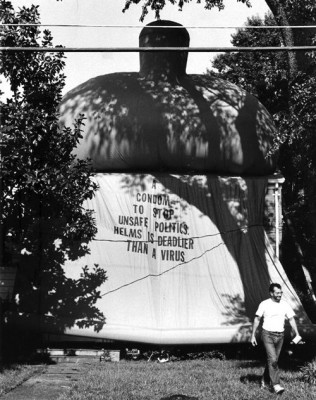
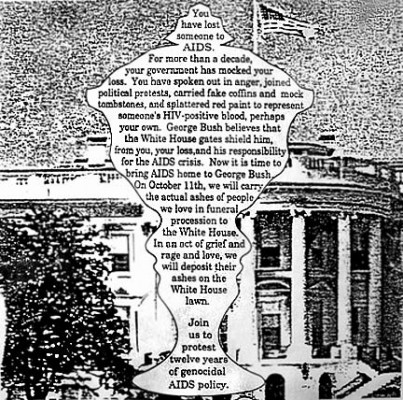


Thanks Jennifer Kabat….reading this felt like reading a poem. As for me, 23 years after diagnosis the meds are at $42,000 thus far this year and counting. It makes AZT seem like the normal.
Thank you, for saying that. And 42k. That is more than I earn a year, the idea of that kind of money is boggling. AZT seems almost quaint, and picturing the state of the world where to live with the disease costs that much is sad beyond belief.
Wow, this is vital information. I had many friends who died of AIDS in the late 80s/90s. In my busyness and self-absorption, I’ve had the image of AIDS in my mind as primarily being “handled” by the cocktail. So the fresh image of the frail guy with the gingham heart replaces the old images.
Yeah it is the tragedy of the disease, and he here in the US can get heart surgery, but what of all the others in the developing world? That’s a bigger tragedy and people think it’s “over there” not here. Also a commenter said his meds cost $40k a year. $40,000. That figure boggles me. It’s more than I earn… Thank you for your kind comments and reading, Judy.